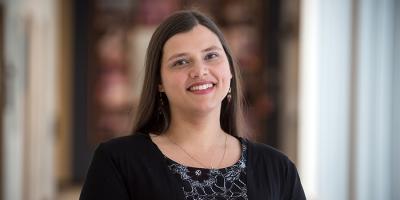 Dr. Lindsay Morcom has been selected as one of the winners of the inaugural Principal's Indigenous Education Award. This award is part of the 2020 Principal's Teaching and Learning Awards, which recognize excellence in the areas of Indigenous education, educational technology, student support, international innovation, and promoting student inquiry.
Dr. Lindsay Morcom has been selected as one of the winners of the inaugural Principal's Indigenous Education Award. This award is part of the 2020 Principal's Teaching and Learning Awards, which recognize excellence in the areas of Indigenous education, educational technology, student support, international innovation, and promoting student inquiry.
Lindsay was kind enough to answer a few questions about the award and the work she's done:
This is a new award – how does it feel to be one of the inaugural winners?
I’m really honoured to be one of the winners of this award. ATEP (Aboriginal Teacher Education Program) is a team effort, and I’m happy that the university is recognizing the value of Indigenous content and pedagogy in this way. I’m excited to be a part of the start of something that will go on to celebrate Indigenous teaching and learning for years to come. I’m also very happy to receive it alongside Melanie Howard, whose work with Aboriginal Access to Engineering has made many important contributions to the university and the community.
Tell us more about creating 3D art in shared virtual reality spaces with Indigenous students.
That project is a collaboration between three of us at Queen’s – Deb St. Amant, Kate Freeman, and me – alongside artist and author Wallace Edwards and Caitlin Fisher, CRC in Digital Culture at York University. We are going to be using virtual reality to connect kids in diverse urban, rural, and First Nation communities to discuss what they want to see for their future and for reconciliation. I’m excited about this project because it brings kids together in a way that the pandemic has really highlighted as necessary, and makes us think about new ways to connect. I’m also really excited to hear from young people. I think young people often have a wonderful understanding of their future and where they want things to go, and any project that allows them to express that, I think, is useful. After all, they will be inheriting whatever we make of reconciliation.
What’s the most important piece of advice you would give to teachers about bringing Indigenous languages, histories, cultures, and knowledges into their classrooms?
For Indigenous teachers, I think the most important thing is to always continue to grow in your own cultural knowledge, and present it well so that your students can also grow in understanding. Be proud of who you are and of all that you’ve accomplished to get into that classroom – and then take action to decolonize and Indigenize so all kids have the best learning opportunities we can imagine for them. For all teachers, but especially non-Indigenous teachers who may not have as much Indigenous knowledge, do your research. Cultural appropriation happens when teachers present concepts in their classes, including material culture, literature, assignments, art, and other activities and lessons, that are rooted in Indigenous cultures that they do not sufficiently understand. It’s absolutely vital that Indigenous kids see themselves in their classrooms, and that Indigenous content is made available to everyone if we are going to deal with the serious issues that have come as a result of settler colonialism. Bringing in guest speakers every once in awhile isn’t enough, and it isn’t fair to expect Indigenous teachers, students, or community members to do all the work to end their own oppression. However, it needs to be done well, with appropriate knowledge, understanding, and consideration of all of our responsibilities in the process of reconciliation.
Want to learn more about bringing Indigenous knowledge into your classroom? Visit our Indigenous Teaching Resources page.
For a taste of Lindsay's work on urban Indigenous language revitalization, we invite you to our Homecoming Pecha Kucha on Friday, October 16.